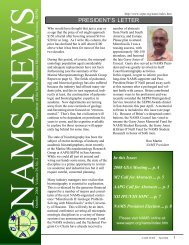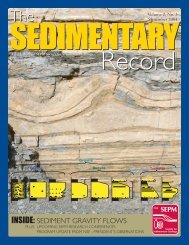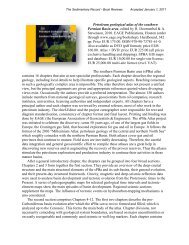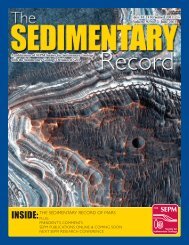PDF of contents and abstracts - SEPM
PDF of contents and abstracts - SEPM
PDF of contents and abstracts - SEPM
You also want an ePaper? Increase the reach of your titles
YUMPU automatically turns print PDFs into web optimized ePapers that Google loves.
is considered to be related to a downdip increase in precipitation <strong>and</strong> decreasing depth to water table. In<br />
the Himalayan system, this is considered to be due to a combination <strong>of</strong> decreasing depth to water table<br />
<strong>and</strong> increased surface flooding due to direct, monsoon-driven precipitation on the DFS surface. An<br />
increase in poorly drained soil development occurs near the toe <strong>of</strong> the DFS in Botswana, despite high<br />
transmission losses across the system.<br />
A key implication from these modern systems is that a change from well-drained to poorly drained soils is<br />
controlled by hydrology. This change occurs along a single isochronous surface that may extend for<br />
hundreds <strong>of</strong> kilometers <strong>and</strong> could be preserved in the rock record. Rock record examples that describe a<br />
downdip change from well-drained to poorly drained soils have been documented previously <strong>and</strong> are<br />
attributed to tectonic, climatic, autocyclic, <strong>and</strong> hydromorphic controls. Our studies from modern DFSs<br />
would suggest that a hydromorphic control is likely to be the most important factor.<br />
Criteria derived from modern DFSs for distinguishing between changes in soil type that record climate<br />
change include the observation that paleosols developed in the proximal well-drained area are likely to be<br />
associated with a s<strong>and</strong>y parent material <strong>and</strong> s<strong>and</strong>-dominated channel facies. In contrast, in the distal<br />
DFSs, more poorly drained soils are likely to be developed on a silt- or clay-rich parent material<br />
interbedded with a mixture <strong>of</strong> s<strong>and</strong>y <strong>and</strong> muddy me<strong>and</strong>ering channel-fill deposits, crevasse splays, <strong>and</strong><br />
floodplain s<strong>and</strong>s <strong>and</strong> muds. Paleosols that record climate change should show no discernible relationship<br />
between parent material <strong>and</strong> soil type. While similar relationships between soil type <strong>and</strong> parent material<br />
have been described previously, their distribution within the context <strong>of</strong> a DFS has not been widely<br />
documented.






